Melbourne's Rail Loop: Construction Strategy and Significance
VerifiedAdded on 2024/06/25
|8
|2153
|365
Report
AI Summary
This report examines the construction of the Melbourne Underground Rail Loop (MURL), also known as the City Loop, in Melbourne, Australia, from its inception in 1971 to its completion in 1985. It explores the motivations behind the project, driven by the need to alleviate congestion at Flinders and Spencer Street stations, which were connected only by the Yarra River and the Flinders Street Viaduct. The report highlights the significance of the MURL in improving train throughput and accessibility for commuters. It delves into the research question of the construction strategy employed and its broader impact on railway construction, utilizing both qualitative and quantitative research methods. Furthermore, the study touches upon the theoretical orientation based on institutional theory, the findings related to the various organizations that managed the MURL over time, and the structure of the thesis, which includes a literature review, research design, data analysis, and conclusions. The report concludes by emphasizing the importance of the MURL as a case study in railway planning and management.
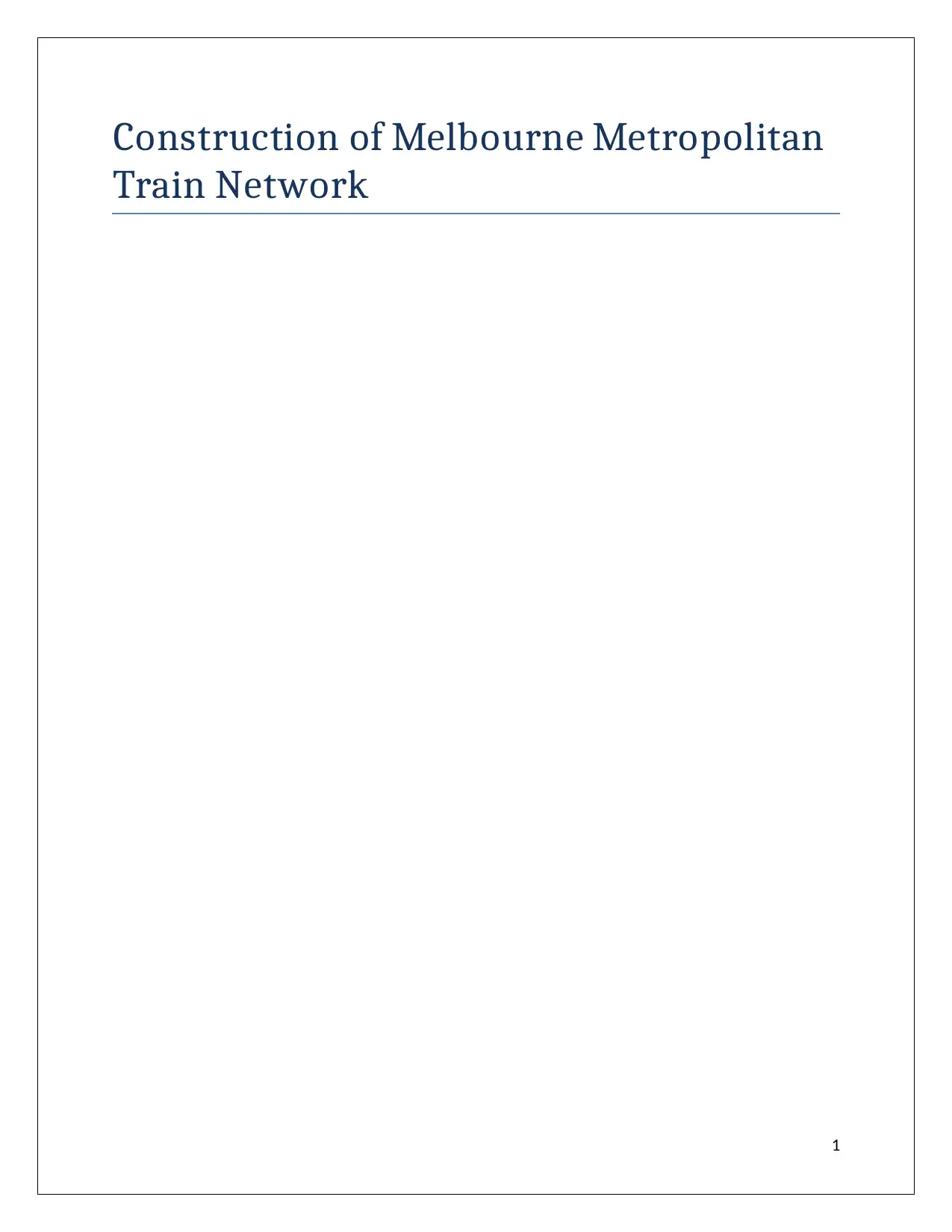
Construction of Melbourne Metropolitan
Train Network
1
Train Network
1
Paraphrase This Document
Need a fresh take? Get an instant paraphrase of this document with our AI Paraphraser
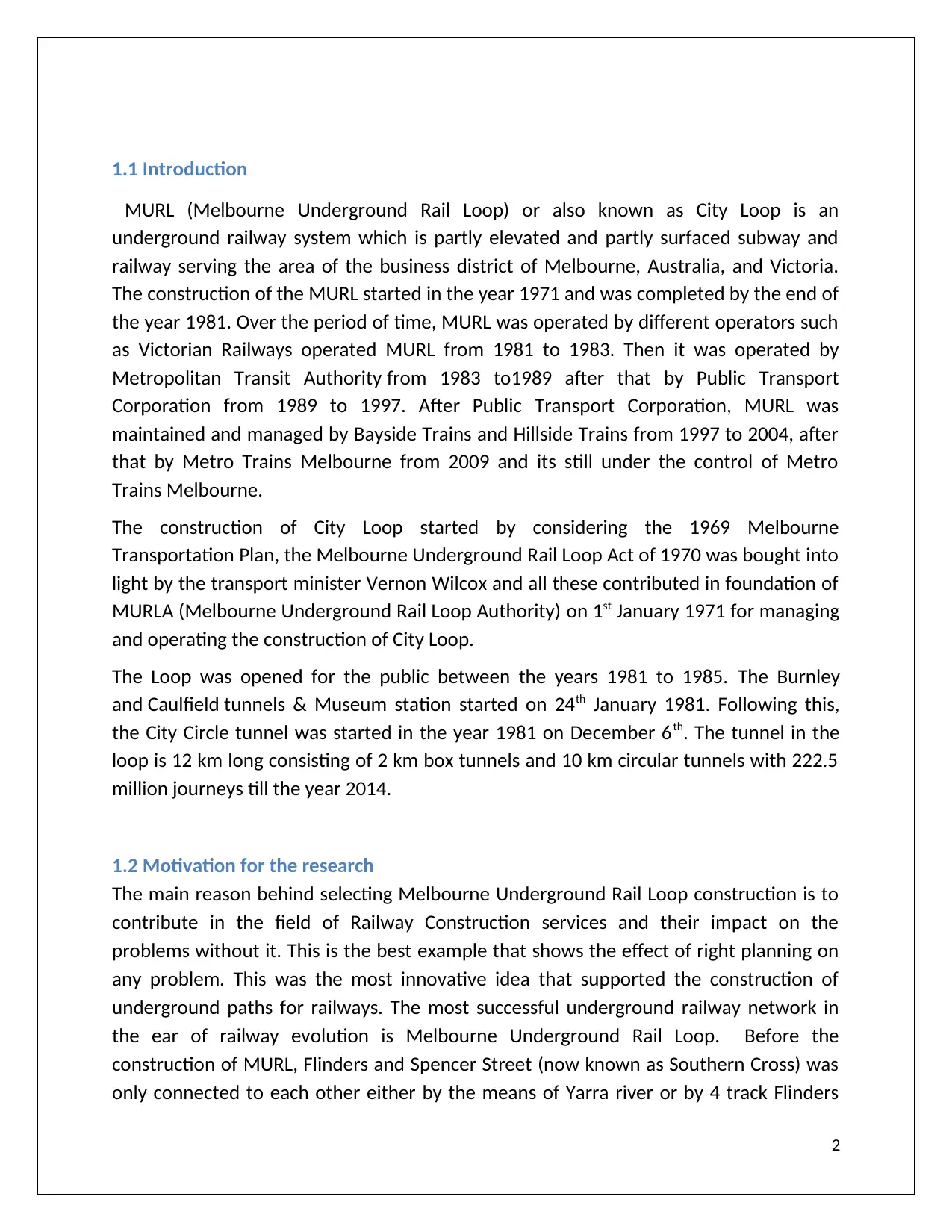
1.1 Introduction
MURL (Melbourne Underground Rail Loop) or also known as City Loop is an
underground railway system which is partly elevated and partly surfaced subway and
railway serving the area of the business district of Melbourne, Australia, and Victoria.
The construction of the MURL started in the year 1971 and was completed by the end of
the year 1981. Over the period of time, MURL was operated by different operators such
as Victorian Railways operated MURL from 1981 to 1983. Then it was operated by
Metropolitan Transit Authority from 1983 to1989 after that by Public Transport
Corporation from 1989 to 1997. After Public Transport Corporation, MURL was
maintained and managed by Bayside Trains and Hillside Trains from 1997 to 2004, after
that by Metro Trains Melbourne from 2009 and its still under the control of Metro
Trains Melbourne.
The construction of City Loop started by considering the 1969 Melbourne
Transportation Plan, the Melbourne Underground Rail Loop Act of 1970 was bought into
light by the transport minister Vernon Wilcox and all these contributed in foundation of
MURLA (Melbourne Underground Rail Loop Authority) on 1st January 1971 for managing
and operating the construction of City Loop.
The Loop was opened for the public between the years 1981 to 1985. The Burnley
and Caulfield tunnels & Museum station started on 24th January 1981. Following this,
the City Circle tunnel was started in the year 1981 on December 6th. The tunnel in the
loop is 12 km long consisting of 2 km box tunnels and 10 km circular tunnels with 222.5
million journeys till the year 2014.
1.2 Motivation for the research
The main reason behind selecting Melbourne Underground Rail Loop construction is to
contribute in the field of Railway Construction services and their impact on the
problems without it. This is the best example that shows the effect of right planning on
any problem. This was the most innovative idea that supported the construction of
underground paths for railways. The most successful underground railway network in
the ear of railway evolution is Melbourne Underground Rail Loop. Before the
construction of MURL, Flinders and Spencer Street (now known as Southern Cross) was
only connected to each other either by the means of Yarra river or by 4 track Flinders
2
MURL (Melbourne Underground Rail Loop) or also known as City Loop is an
underground railway system which is partly elevated and partly surfaced subway and
railway serving the area of the business district of Melbourne, Australia, and Victoria.
The construction of the MURL started in the year 1971 and was completed by the end of
the year 1981. Over the period of time, MURL was operated by different operators such
as Victorian Railways operated MURL from 1981 to 1983. Then it was operated by
Metropolitan Transit Authority from 1983 to1989 after that by Public Transport
Corporation from 1989 to 1997. After Public Transport Corporation, MURL was
maintained and managed by Bayside Trains and Hillside Trains from 1997 to 2004, after
that by Metro Trains Melbourne from 2009 and its still under the control of Metro
Trains Melbourne.
The construction of City Loop started by considering the 1969 Melbourne
Transportation Plan, the Melbourne Underground Rail Loop Act of 1970 was bought into
light by the transport minister Vernon Wilcox and all these contributed in foundation of
MURLA (Melbourne Underground Rail Loop Authority) on 1st January 1971 for managing
and operating the construction of City Loop.
The Loop was opened for the public between the years 1981 to 1985. The Burnley
and Caulfield tunnels & Museum station started on 24th January 1981. Following this,
the City Circle tunnel was started in the year 1981 on December 6th. The tunnel in the
loop is 12 km long consisting of 2 km box tunnels and 10 km circular tunnels with 222.5
million journeys till the year 2014.
1.2 Motivation for the research
The main reason behind selecting Melbourne Underground Rail Loop construction is to
contribute in the field of Railway Construction services and their impact on the
problems without it. This is the best example that shows the effect of right planning on
any problem. This was the most innovative idea that supported the construction of
underground paths for railways. The most successful underground railway network in
the ear of railway evolution is Melbourne Underground Rail Loop. Before the
construction of MURL, Flinders and Spencer Street (now known as Southern Cross) was
only connected to each other either by the means of Yarra river or by 4 track Flinders
2
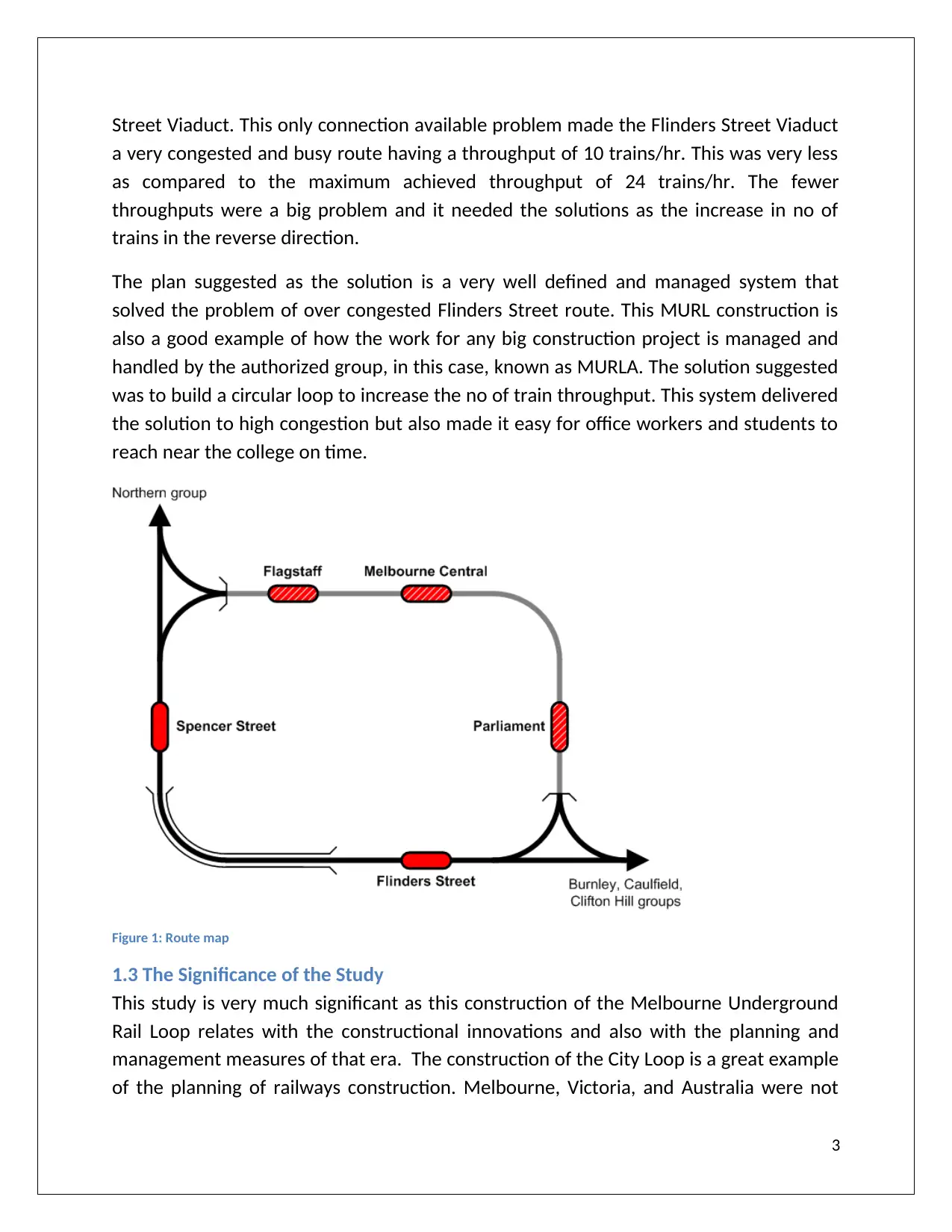
Street Viaduct. This only connection available problem made the Flinders Street Viaduct
a very congested and busy route having a throughput of 10 trains/hr. This was very less
as compared to the maximum achieved throughput of 24 trains/hr. The fewer
throughputs were a big problem and it needed the solutions as the increase in no of
trains in the reverse direction.
The plan suggested as the solution is a very well defined and managed system that
solved the problem of over congested Flinders Street route. This MURL construction is
also a good example of how the work for any big construction project is managed and
handled by the authorized group, in this case, known as MURLA. The solution suggested
was to build a circular loop to increase the no of train throughput. This system delivered
the solution to high congestion but also made it easy for office workers and students to
reach near the college on time.
Figure 1: Route map
1.3 The Significance of the Study
This study is very much significant as this construction of the Melbourne Underground
Rail Loop relates with the constructional innovations and also with the planning and
management measures of that era. The construction of the City Loop is a great example
of the planning of railways construction. Melbourne, Victoria, and Australia were not
3
a very congested and busy route having a throughput of 10 trains/hr. This was very less
as compared to the maximum achieved throughput of 24 trains/hr. The fewer
throughputs were a big problem and it needed the solutions as the increase in no of
trains in the reverse direction.
The plan suggested as the solution is a very well defined and managed system that
solved the problem of over congested Flinders Street route. This MURL construction is
also a good example of how the work for any big construction project is managed and
handled by the authorized group, in this case, known as MURLA. The solution suggested
was to build a circular loop to increase the no of train throughput. This system delivered
the solution to high congestion but also made it easy for office workers and students to
reach near the college on time.
Figure 1: Route map
1.3 The Significance of the Study
This study is very much significant as this construction of the Melbourne Underground
Rail Loop relates with the constructional innovations and also with the planning and
management measures of that era. The construction of the City Loop is a great example
of the planning of railways construction. Melbourne, Victoria, and Australia were not
3
⊘ This is a preview!⊘
Do you want full access?
Subscribe today to unlock all pages.

Trusted by 1+ million students worldwide
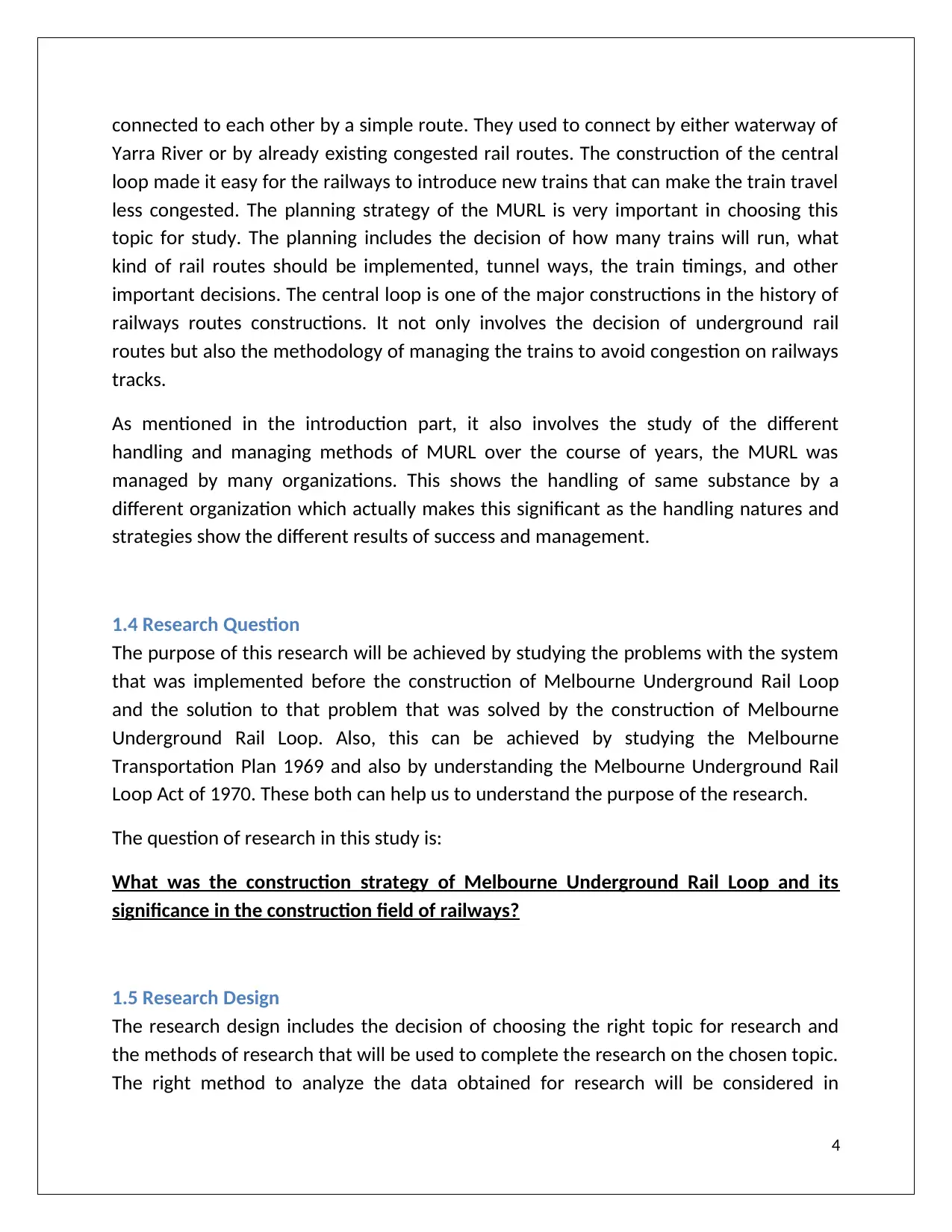
connected to each other by a simple route. They used to connect by either waterway of
Yarra River or by already existing congested rail routes. The construction of the central
loop made it easy for the railways to introduce new trains that can make the train travel
less congested. The planning strategy of the MURL is very important in choosing this
topic for study. The planning includes the decision of how many trains will run, what
kind of rail routes should be implemented, tunnel ways, the train timings, and other
important decisions. The central loop is one of the major constructions in the history of
railways routes constructions. It not only involves the decision of underground rail
routes but also the methodology of managing the trains to avoid congestion on railways
tracks.
As mentioned in the introduction part, it also involves the study of the different
handling and managing methods of MURL over the course of years, the MURL was
managed by many organizations. This shows the handling of same substance by a
different organization which actually makes this significant as the handling natures and
strategies show the different results of success and management.
1.4 Research Question
The purpose of this research will be achieved by studying the problems with the system
that was implemented before the construction of Melbourne Underground Rail Loop
and the solution to that problem that was solved by the construction of Melbourne
Underground Rail Loop. Also, this can be achieved by studying the Melbourne
Transportation Plan 1969 and also by understanding the Melbourne Underground Rail
Loop Act of 1970. These both can help us to understand the purpose of the research.
The question of research in this study is:
What was the construction strategy of Melbourne Underground Rail Loop and its
significance in the construction field of railways?
1.5 Research Design
The research design includes the decision of choosing the right topic for research and
the methods of research that will be used to complete the research on the chosen topic.
The right method to analyze the data obtained for research will be considered in
4
Yarra River or by already existing congested rail routes. The construction of the central
loop made it easy for the railways to introduce new trains that can make the train travel
less congested. The planning strategy of the MURL is very important in choosing this
topic for study. The planning includes the decision of how many trains will run, what
kind of rail routes should be implemented, tunnel ways, the train timings, and other
important decisions. The central loop is one of the major constructions in the history of
railways routes constructions. It not only involves the decision of underground rail
routes but also the methodology of managing the trains to avoid congestion on railways
tracks.
As mentioned in the introduction part, it also involves the study of the different
handling and managing methods of MURL over the course of years, the MURL was
managed by many organizations. This shows the handling of same substance by a
different organization which actually makes this significant as the handling natures and
strategies show the different results of success and management.
1.4 Research Question
The purpose of this research will be achieved by studying the problems with the system
that was implemented before the construction of Melbourne Underground Rail Loop
and the solution to that problem that was solved by the construction of Melbourne
Underground Rail Loop. Also, this can be achieved by studying the Melbourne
Transportation Plan 1969 and also by understanding the Melbourne Underground Rail
Loop Act of 1970. These both can help us to understand the purpose of the research.
The question of research in this study is:
What was the construction strategy of Melbourne Underground Rail Loop and its
significance in the construction field of railways?
1.5 Research Design
The research design includes the decision of choosing the right topic for research and
the methods of research that will be used to complete the research on the chosen topic.
The right method to analyze the data obtained for research will be considered in
4
Paraphrase This Document
Need a fresh take? Get an instant paraphrase of this document with our AI Paraphraser
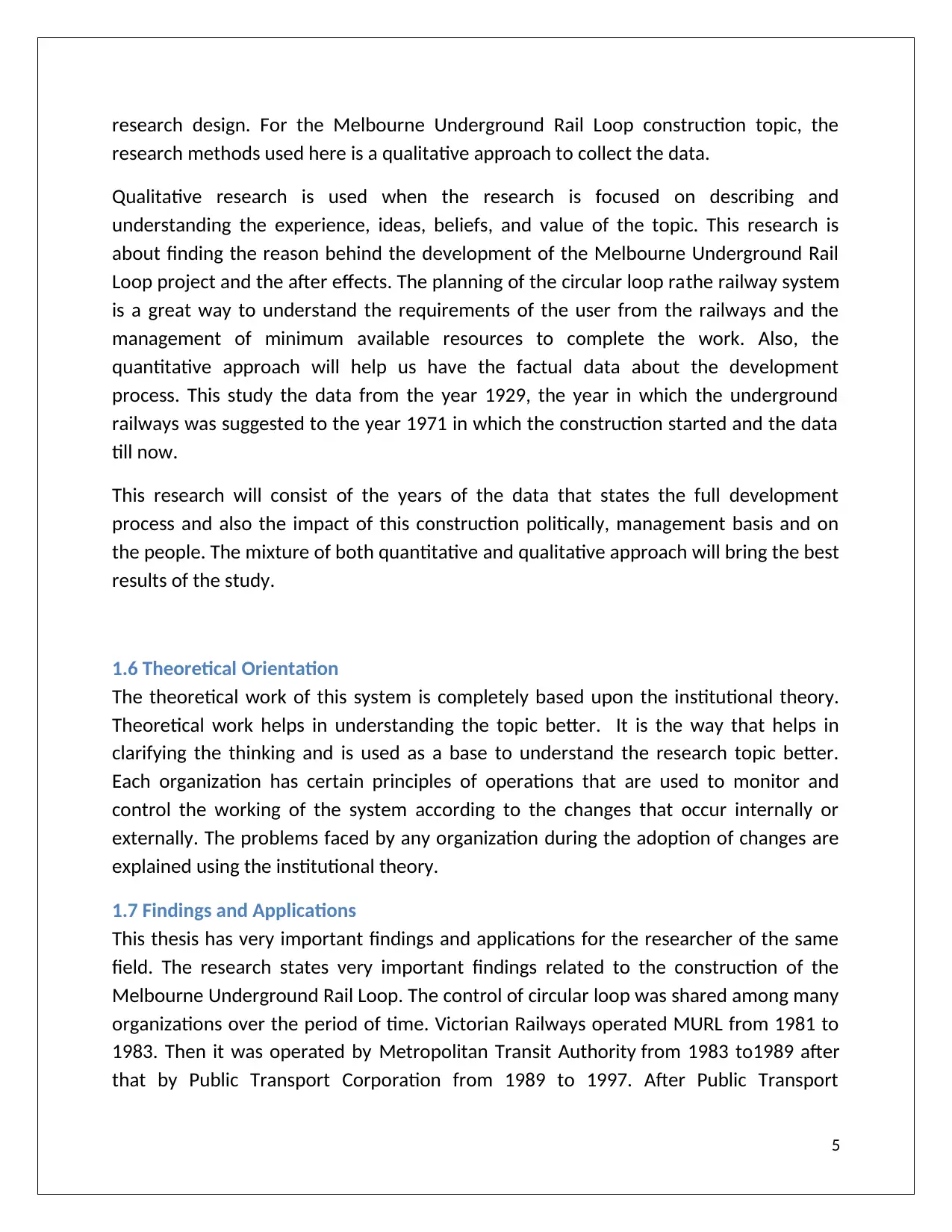
research design. For the Melbourne Underground Rail Loop construction topic, the
research methods used here is a qualitative approach to collect the data.
Qualitative research is used when the research is focused on describing and
understanding the experience, ideas, beliefs, and value of the topic. This research is
about finding the reason behind the development of the Melbourne Underground Rail
Loop project and the after effects. The planning of the circular loop rathe railway system
is a great way to understand the requirements of the user from the railways and the
management of minimum available resources to complete the work. Also, the
quantitative approach will help us have the factual data about the development
process. This study the data from the year 1929, the year in which the underground
railways was suggested to the year 1971 in which the construction started and the data
till now.
This research will consist of the years of the data that states the full development
process and also the impact of this construction politically, management basis and on
the people. The mixture of both quantitative and qualitative approach will bring the best
results of the study.
1.6 Theoretical Orientation
The theoretical work of this system is completely based upon the institutional theory.
Theoretical work helps in understanding the topic better. It is the way that helps in
clarifying the thinking and is used as a base to understand the research topic better.
Each organization has certain principles of operations that are used to monitor and
control the working of the system according to the changes that occur internally or
externally. The problems faced by any organization during the adoption of changes are
explained using the institutional theory.
1.7 Findings and Applications
This thesis has very important findings and applications for the researcher of the same
field. The research states very important findings related to the construction of the
Melbourne Underground Rail Loop. The control of circular loop was shared among many
organizations over the period of time. Victorian Railways operated MURL from 1981 to
1983. Then it was operated by Metropolitan Transit Authority from 1983 to1989 after
that by Public Transport Corporation from 1989 to 1997. After Public Transport
5
research methods used here is a qualitative approach to collect the data.
Qualitative research is used when the research is focused on describing and
understanding the experience, ideas, beliefs, and value of the topic. This research is
about finding the reason behind the development of the Melbourne Underground Rail
Loop project and the after effects. The planning of the circular loop rathe railway system
is a great way to understand the requirements of the user from the railways and the
management of minimum available resources to complete the work. Also, the
quantitative approach will help us have the factual data about the development
process. This study the data from the year 1929, the year in which the underground
railways was suggested to the year 1971 in which the construction started and the data
till now.
This research will consist of the years of the data that states the full development
process and also the impact of this construction politically, management basis and on
the people. The mixture of both quantitative and qualitative approach will bring the best
results of the study.
1.6 Theoretical Orientation
The theoretical work of this system is completely based upon the institutional theory.
Theoretical work helps in understanding the topic better. It is the way that helps in
clarifying the thinking and is used as a base to understand the research topic better.
Each organization has certain principles of operations that are used to monitor and
control the working of the system according to the changes that occur internally or
externally. The problems faced by any organization during the adoption of changes are
explained using the institutional theory.
1.7 Findings and Applications
This thesis has very important findings and applications for the researcher of the same
field. The research states very important findings related to the construction of the
Melbourne Underground Rail Loop. The control of circular loop was shared among many
organizations over the period of time. Victorian Railways operated MURL from 1981 to
1983. Then it was operated by Metropolitan Transit Authority from 1983 to1989 after
that by Public Transport Corporation from 1989 to 1997. After Public Transport
5
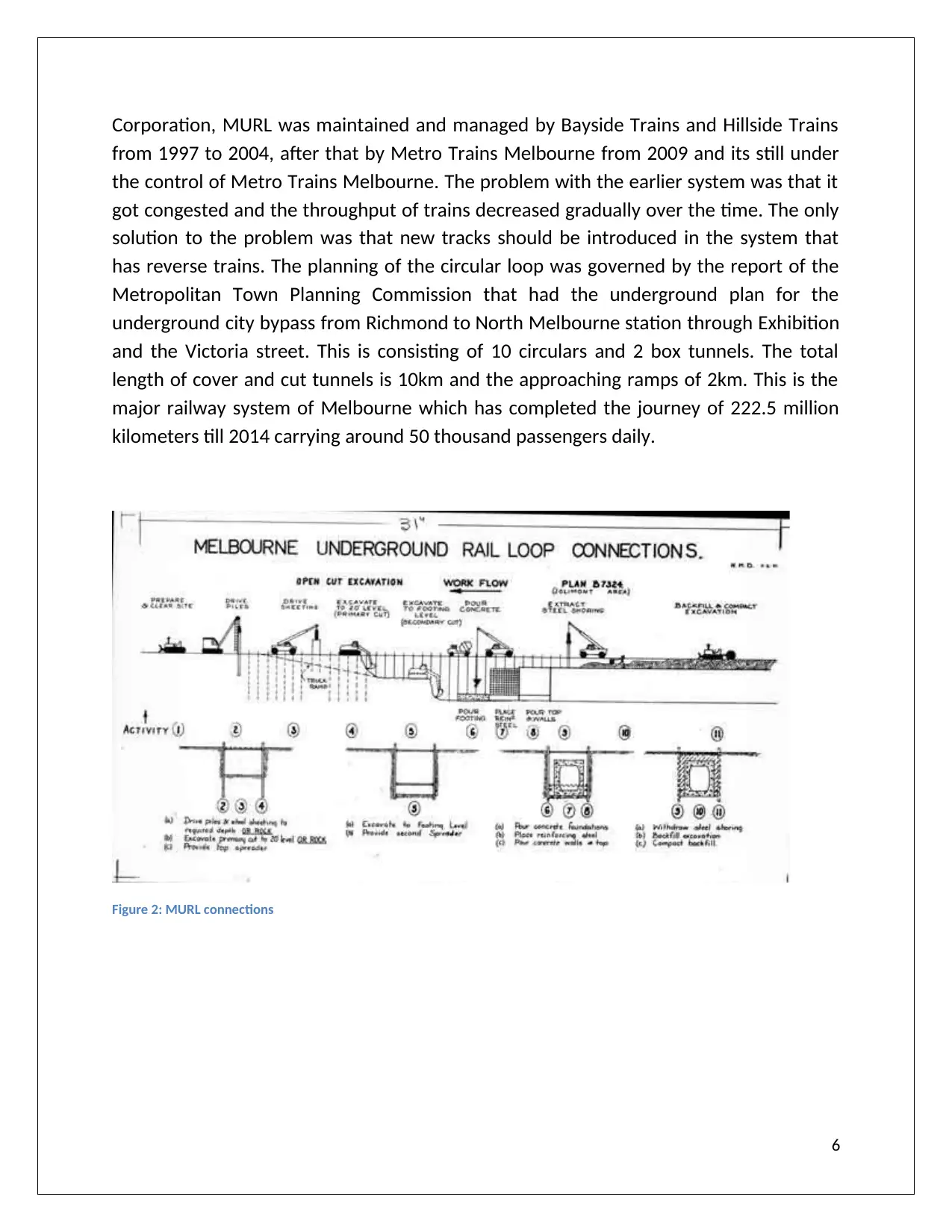
Corporation, MURL was maintained and managed by Bayside Trains and Hillside Trains
from 1997 to 2004, after that by Metro Trains Melbourne from 2009 and its still under
the control of Metro Trains Melbourne. The problem with the earlier system was that it
got congested and the throughput of trains decreased gradually over the time. The only
solution to the problem was that new tracks should be introduced in the system that
has reverse trains. The planning of the circular loop was governed by the report of the
Metropolitan Town Planning Commission that had the underground plan for the
underground city bypass from Richmond to North Melbourne station through Exhibition
and the Victoria street. This is consisting of 10 circulars and 2 box tunnels. The total
length of cover and cut tunnels is 10km and the approaching ramps of 2km. This is the
major railway system of Melbourne which has completed the journey of 222.5 million
kilometers till 2014 carrying around 50 thousand passengers daily.
Figure 2: MURL connections
6
from 1997 to 2004, after that by Metro Trains Melbourne from 2009 and its still under
the control of Metro Trains Melbourne. The problem with the earlier system was that it
got congested and the throughput of trains decreased gradually over the time. The only
solution to the problem was that new tracks should be introduced in the system that
has reverse trains. The planning of the circular loop was governed by the report of the
Metropolitan Town Planning Commission that had the underground plan for the
underground city bypass from Richmond to North Melbourne station through Exhibition
and the Victoria street. This is consisting of 10 circulars and 2 box tunnels. The total
length of cover and cut tunnels is 10km and the approaching ramps of 2km. This is the
major railway system of Melbourne which has completed the journey of 222.5 million
kilometers till 2014 carrying around 50 thousand passengers daily.
Figure 2: MURL connections
6
⊘ This is a preview!⊘
Do you want full access?
Subscribe today to unlock all pages.

Trusted by 1+ million students worldwide
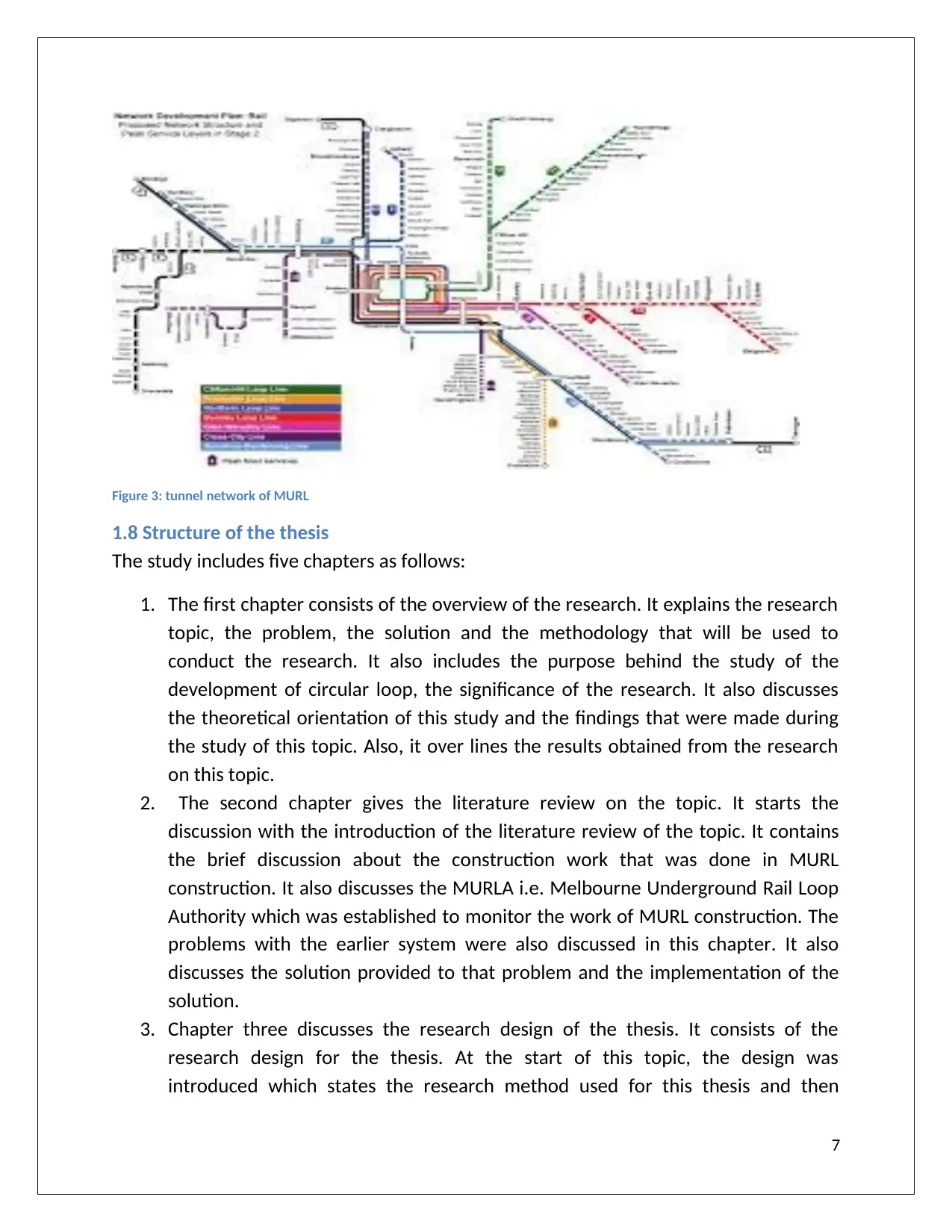
Figure 3: tunnel network of MURL
1.8 Structure of the thesis
The study includes five chapters as follows:
1. The first chapter consists of the overview of the research. It explains the research
topic, the problem, the solution and the methodology that will be used to
conduct the research. It also includes the purpose behind the study of the
development of circular loop, the significance of the research. It also discusses
the theoretical orientation of this study and the findings that were made during
the study of this topic. Also, it over lines the results obtained from the research
on this topic.
2. The second chapter gives the literature review on the topic. It starts the
discussion with the introduction of the literature review of the topic. It contains
the brief discussion about the construction work that was done in MURL
construction. It also discusses the MURLA i.e. Melbourne Underground Rail Loop
Authority which was established to monitor the work of MURL construction. The
problems with the earlier system were also discussed in this chapter. It also
discusses the solution provided to that problem and the implementation of the
solution.
3. Chapter three discusses the research design of the thesis. It consists of the
research design for the thesis. At the start of this topic, the design was
introduced which states the research method used for this thesis and then
7
1.8 Structure of the thesis
The study includes five chapters as follows:
1. The first chapter consists of the overview of the research. It explains the research
topic, the problem, the solution and the methodology that will be used to
conduct the research. It also includes the purpose behind the study of the
development of circular loop, the significance of the research. It also discusses
the theoretical orientation of this study and the findings that were made during
the study of this topic. Also, it over lines the results obtained from the research
on this topic.
2. The second chapter gives the literature review on the topic. It starts the
discussion with the introduction of the literature review of the topic. It contains
the brief discussion about the construction work that was done in MURL
construction. It also discusses the MURLA i.e. Melbourne Underground Rail Loop
Authority which was established to monitor the work of MURL construction. The
problems with the earlier system were also discussed in this chapter. It also
discusses the solution provided to that problem and the implementation of the
solution.
3. Chapter three discusses the research design of the thesis. It consists of the
research design for the thesis. At the start of this topic, the design was
introduced which states the research method used for this thesis and then
7
Paraphrase This Document
Need a fresh take? Get an instant paraphrase of this document with our AI Paraphraser
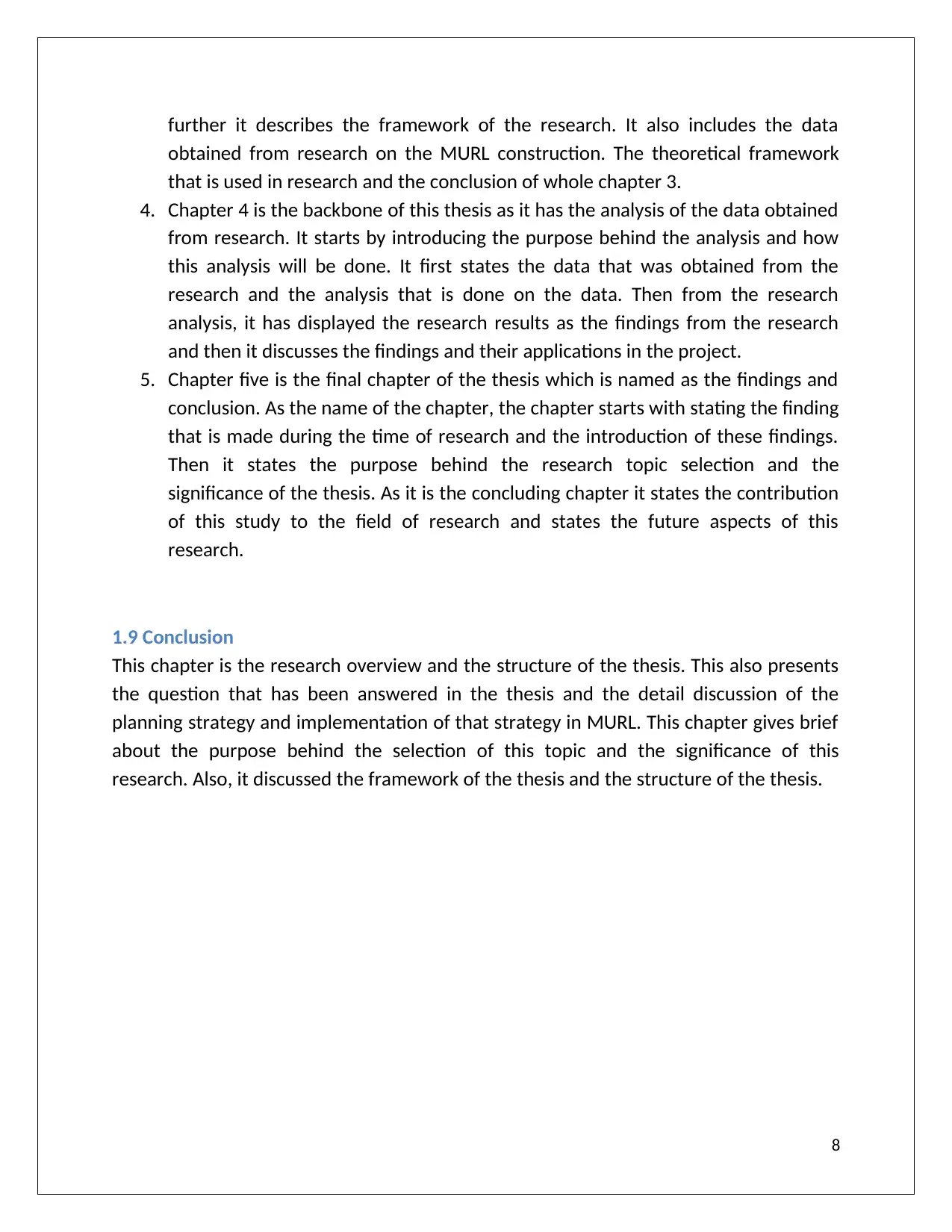
further it describes the framework of the research. It also includes the data
obtained from research on the MURL construction. The theoretical framework
that is used in research and the conclusion of whole chapter 3.
4. Chapter 4 is the backbone of this thesis as it has the analysis of the data obtained
from research. It starts by introducing the purpose behind the analysis and how
this analysis will be done. It first states the data that was obtained from the
research and the analysis that is done on the data. Then from the research
analysis, it has displayed the research results as the findings from the research
and then it discusses the findings and their applications in the project.
5. Chapter five is the final chapter of the thesis which is named as the findings and
conclusion. As the name of the chapter, the chapter starts with stating the finding
that is made during the time of research and the introduction of these findings.
Then it states the purpose behind the research topic selection and the
significance of the thesis. As it is the concluding chapter it states the contribution
of this study to the field of research and states the future aspects of this
research.
1.9 Conclusion
This chapter is the research overview and the structure of the thesis. This also presents
the question that has been answered in the thesis and the detail discussion of the
planning strategy and implementation of that strategy in MURL. This chapter gives brief
about the purpose behind the selection of this topic and the significance of this
research. Also, it discussed the framework of the thesis and the structure of the thesis.
8
obtained from research on the MURL construction. The theoretical framework
that is used in research and the conclusion of whole chapter 3.
4. Chapter 4 is the backbone of this thesis as it has the analysis of the data obtained
from research. It starts by introducing the purpose behind the analysis and how
this analysis will be done. It first states the data that was obtained from the
research and the analysis that is done on the data. Then from the research
analysis, it has displayed the research results as the findings from the research
and then it discusses the findings and their applications in the project.
5. Chapter five is the final chapter of the thesis which is named as the findings and
conclusion. As the name of the chapter, the chapter starts with stating the finding
that is made during the time of research and the introduction of these findings.
Then it states the purpose behind the research topic selection and the
significance of the thesis. As it is the concluding chapter it states the contribution
of this study to the field of research and states the future aspects of this
research.
1.9 Conclusion
This chapter is the research overview and the structure of the thesis. This also presents
the question that has been answered in the thesis and the detail discussion of the
planning strategy and implementation of that strategy in MURL. This chapter gives brief
about the purpose behind the selection of this topic and the significance of this
research. Also, it discussed the framework of the thesis and the structure of the thesis.
8
1 out of 8
Your All-in-One AI-Powered Toolkit for Academic Success.
+13062052269
info@desklib.com
Available 24*7 on WhatsApp / Email
![[object Object]](/_next/static/media/star-bottom.7253800d.svg)
Unlock your academic potential
Copyright © 2020–2025 A2Z Services. All Rights Reserved. Developed and managed by ZUCOL.
